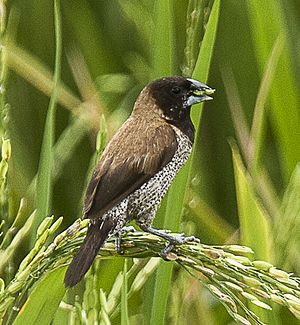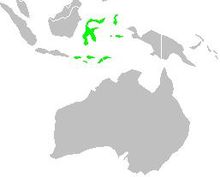Wave belly bronze men
| Wave belly bronze men | ||||||||||||
|---|---|---|---|---|---|---|---|---|---|---|---|---|

Wave belly bronze male, Sulawesi |
||||||||||||
| Systematics | ||||||||||||
|
||||||||||||
| Scientific name | ||||||||||||
| Lonchura molucca | ||||||||||||
| ( Linnaeus , 1766) |
The wave- bellied bronze man ( Lonchura molucca ), also known as the wave- bellied bronze man or Moluccan nun , is a species of the finch family . Several subspecies are distinguished.
description
The wave-bellied bronze male reaches a body length of eleven centimeters and thus belongs to the medium-sized splendid finch species. There is no sexual dimorphism .
The front of the head as well as the throat, the head and the chest are black. On the flanks and on the belly there is a black and white wave drawing, which gave the species its German name. The tail is matt black, the back and the wing covers are light brown. The lower beak of the beak, which is very strong overall, is silvery, while the upper beak is black. The feet and legs are lead gray.
Young birds lack the black on their heads, they are dark brown in these areas. The sides of the head and the throat are earth brown. The underside of the body is yellowish-brown with an only indistinct transverse wave.
Way of life and distribution
The wave-belly bronze man's distribution area is Sulawesi and the Moluccas and the Lesser Sunda Islands . The species occurs there in a total of three subspecies. The preferred habitat are the wilderness of Alangalang , bushes shot through with grass at the edge of the forest and in clearings. The species has also opened up to human settlement areas and occurs on cultivated land as well as in the vicinity of human settlements. Wave belly bronze men occur up to an altitude of 1,000 meters above sea level. The diet consists of fine grass and weed seeds.
The breeding season varies depending on the distribution area. In the west of Flores they breed from March to June, in Central Sulawesi the breeding season falls between July and September and January. Wave-bellied bronze males often breed in loose colonies. Their breeding place is bushes or the dense branches of trees. The nest is a ball nest. The clutch comprises four to five eggs. They are incubated by the parent birds for 15 days. The nestling period is 18 to 19 days. The parent birds look after them for another ten days after they have left the nest.
attitude
The wave belly bronze male was first introduced to Europe in 1879. The next imports took place again in 1969, 1976 and 1980. The first breeding of this species also took place in the 1980s. Because of its peaceful nature, this bronze male species is considered an ideal aviary and is now regularly bred.
supporting documents
literature
- Horst Bielfeld : Knowing and caring for 300 ornamental birds. Ulmer Verlag, Stuttgart 2009, ISBN 978-3-8001-5737-2 .
- Jürgen Nicolai (Ed.), Joachim Steinbacher (Ed.), Renate van den Elzen, Gerhard Hofmann: Prachtfinken - Australia, Oceania, Southeast Asia . Eugen Ulmer Verlag, Stuttgart 2001, ISBN 3-8001-3249-4 .
- Peter Clement , Alan Harris, John Davis: Finches and Sparrows. An Identification Guide. Christopher Helm, London 1993, ISBN 0-7136-8017-2 .
Single receipts
- ↑ Nicolai et al., P. 287
Web links
- Lonchura molucca inthe IUCN 2013 Red List of Threatened Species . Listed by: BirdLife International, 2012. Retrieved September 4, 2013.
